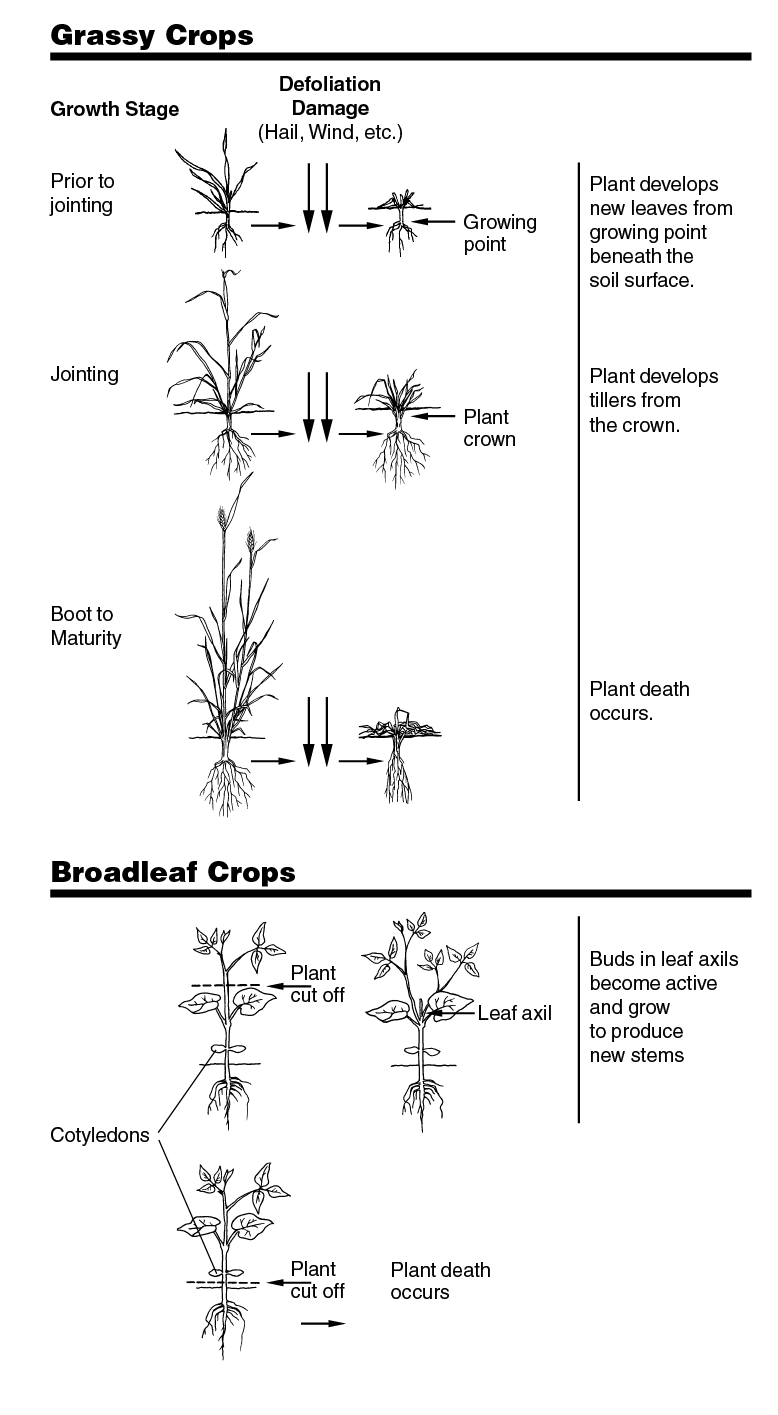Evaluating crop injury and estimating potential crop yield is the first step in determining if a crop should be replanted. The best possible evaluation of the surviving stand is needed because the critical yield comparison ultimately will be between the suboptimal stand from the original planting date versus a full stand from a later than optimum planting date.
During the seedling stage, injury that results in stand reduction will cause the greatest yield reductions. Leaf injury or loss during early stages has a minimal effect on yield; however, as the crop approaches reproductive developmental stages, leaf damage or loss is more detrimental to yield. An assessment of potential plant stand soon after crop injury occurs (within a week) is critical to avoid delays if replanting is necessary.
An accurate determination of the existing stand must be made. Stand counts should be taken at random from several areas in damaged portions of the field. Determining stand level may be more complicated than simply counting plants. If seedling emergence is uneven, an evaluation of potential late-emerging plants should be made. Plant damage and loss in fields often is distributed randomly throughout a field and this complicates decision making.
In early plant development, a few key structures are indicators of potential plant survival. A healthy root system and seedling tissue are needed during plant establishment (see Figure 1 for key structures). If these structures appear normal and the depth of the seed is not excessive, emergence likely will occur when soil moisture is adequate. Destruction of leaf area on young plants is seldom as detrimental to subsequent plant growth and yield as the initial appearance may suggest. If the growing point of the small grain is not damaged and the stem is not broken below the cotyledon node of broadleaf crops, the plants likely will recover.
Figure 1. Effect of injury on grassy crops at different growth stages and on broadleaf crops.
During early growth stages, most North Dakota crops can sustain some stand loss without experiencing significant yield reduction. Crops compensate for stand reduction through tillering, secondary branching or increased head number, and increased ear, head or seed size.
Comparison of the estimated yield of the injured crop with expected yield of an alternative crop minus reseeding costs must be considered. Often this calculation will reveal that the present crop stand will be more viable economically than a later replanted crop.
Table 1 shows the population levels of several crops that should be considered minimum stands when deciding whether to replant, assuming the plant population is relatively uniform in distribution. As the season progresses, the yield potential of a newly planted crop is reduced (Tables 2 and 3); herefore, the lower minimum stand values from Table 1 should be utilized as the season progresses.
Table 1. Minimum stand levels of several crops that should be
considered acceptable before replanting is done.
Table 1. Minimum stand levels of several crops that should be considered acceptable before replanting is done.
|
Crop
|
% of
Normal Stand
|
Minimum Stand
|
Units/Notes
|
|
Canola
|
25-50
|
4
|
plants/ft2
|
|
Corn: Irrigated
|
50-60
|
17,000-20,000
|
plants/A
|
|
Corn: Dryland
|
40-50
|
13,000-16,000
|
plants/A
|
|
Dry Bean: Navy and Black
|
40-50
|
36,000-60,000
|
plants/A
|
|
Dry Bean: Pinto
|
40-50
|
28,000-40,000
|
plants/A
|
|
Field pea
|
40-70
|
3-5
|
plants/ft2
|
|
Flax
|
20-40
|
20-35
|
plants/ft2
|
|
Safflower
|
40-50
|
2-2.5
|
plants/ft2
|
|
Small Grain
|
30-40
|
8-14
|
plants/ft2
|
|
Soybean
|
50
|
75,000
|
plants/A
|
|
Sunflower
|
50-60
|
8,000-11,000
|
plants/A
|
During early development, the growing point of cereal crops is below the soil surface, making them less susceptible to injury. With this protection, plants can suffer the loss of above-ground foliage without dying.
When hail, frost or similar types of injury cause severe foliar damage, waiting several days after the injury occurs to make an accurate determination of stand reduction is advisable. After this period, new growth on plants with uninjured growing points can be observed as in Figure 1. If no regrowth is observed, the stem of the plant may be cut in half to inspect the growing point. The growing point should be white or cream-colored. Darkening or softening of the growing point usually precedes plant death.
When the growing point moves above the soil surface at jointing in small grain and the sixth leaf stage in corn, it becomes more vulnerable to physical damage.
Table 2. Expected yield reductions when planting cool-season crops late in North Dakota.
|
Crop
|
Yield loss/day
|
| |
(%)a
|
|
Barley
|
1.7
|
|
Wheat
|
1.5
|
|
Oat
|
1.2
|
|
Canola
|
1.9
|
|
Field Pea
|
2.1
|
|
Flax
|
2.3
|
a Percent of optimal planting date.
Table 3. Expected yield reductions when planting corn, soybean and sunflower late in North Dakota.
|
Crop
|
Yield loss/day
|
| |
(%)a
|
|
Cornb
|
2.0
|
|
Soybeanc
|
0.8
|
|
Sunflowerd
|
1.8
|
aPercent of optimal planting date.
bPlanting after May 25.
cPlanting after May 15.
dPlanting after May 31.

